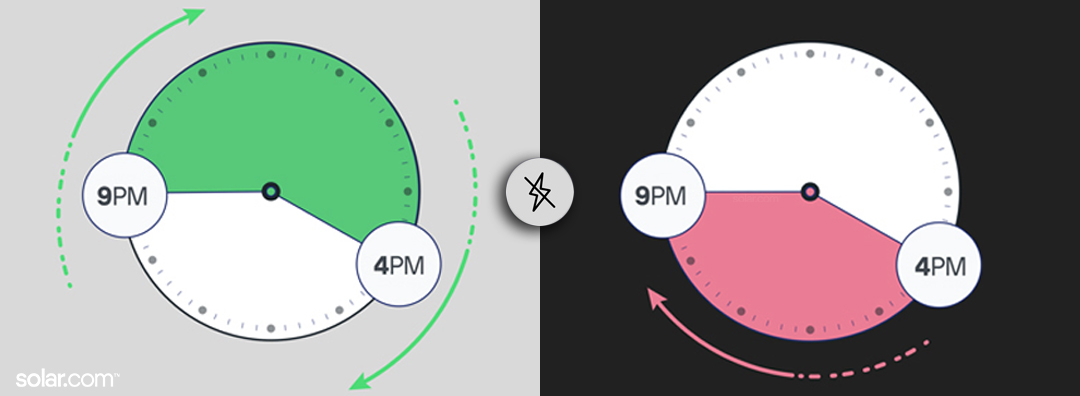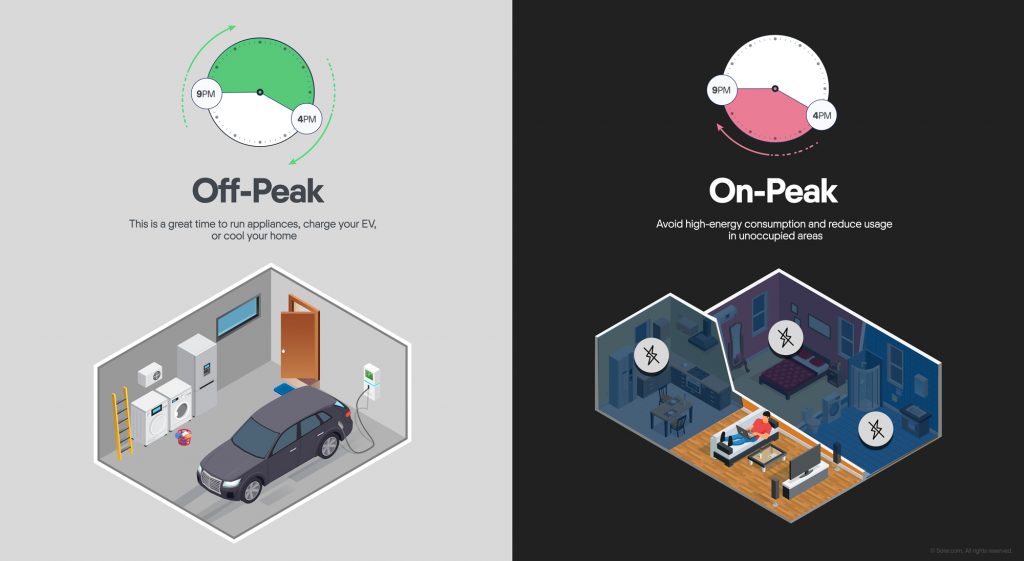See how much solar panels cost in your area

Please enter a valid zip code.
Zero Upfront Cost
Best Price Guaranteed
![]()
![]()
Solar Learning Center > The Pros and Cons of Rooftop Solar in 2025 > Time of Use Rates - Your TOU Rates Guide
Time of Use Rates - Your TOU Rates Guide

Time-of-Use Rates (TOU) were introduced by many electricity providers back in the early 2010s. However, over a decade later, most homeowners are still unaware of its significant impact on their monthly energy expenses.
What is TOU?
Time-of-Use (TOU) rates are a dynamic electric rate schedule that adjusts prices based on the time of day and season, aiming to align with grid demands. This option is increasingly offered by utilities to homeowners, incentivising them to avoid higher rates during peak-demand weekdays by consuming more electricity during off-peak hours.
For example, in the summer TOU rate plan for Southern California Edison (SCE) shown below, the cost electricity increases from 36 to 71 cents per kWh between 5 pm and 8 pm on weekdays.

For homeowners, time-of-use rates are a double-edged sword.
On one hand, they provide an opportunity to reduce your energy costs by shifting your electricity consumption. On the other, if they can cause your energy costs to increase if you are not willing or able to adapt to the rate schedule.
For example, if you work from home, it’s easier to do laundry and charge your EV during off-peak hours in order to avoid peak pricing. However, if you are commuting and working between 8 am and 5 pm every day, avoiding peak pricing becomes more difficult.
There’s also the issue of air conditioning — which is largest electrical load in most households.
By 5 pm, most people are home from school and work and the summer sun has been beating down on all day. This is typically when homeowners fire up the AC. However, it’s also when peak TOU rates kick in, making for a difficult decision between a comfortable house and a manageable utility bill.
With home solar, this decision becomes much easier, as you can confidently turn on the AC without worrying about a runaway utility bill.
How do TOU rates work?
Simply put, TOU rates work by charging different prices for electricity throughout the day, week, and season to align with demand.
TOU rate plans may vary by region and utility company, some specific terminology will stay consistent. First, there is typically seperate TOU rate plans for summer and winter, with summer plans being markedly more expensive.
Plans are often divided into the following pricing segments:
- Super off-peak
- Off-peak
- Peak
- Super-peak
For example, the graph below shows the time-of-use rates for Con Edison, the electricity utility in New York City.

Peak and super-peak hours are times when electricity demand is the highest, as people are coming home from work and school to turn on the AC, cook dinner, do laundry, play video games, and charge devices.
Off-Peak hours are just that; they typically run from early morning to late afternoon. Sometimes this can fall under a few other categories such as Mid-Peak or Super Off-Peak. They are all just variations of this time frame with different rates.
Few people are home during this time, so the demand will be lower, resulting in a lower rate. Making this time range the most suitable for homeowners to run higher energy-consuming appliances during those times to get the lower rates, keeping their monthly bills to a minimum.
Try to schedule your heating and cooling systems to run early or mid-morning. That way, you can pre-cool or heat your home and set the temperature to a warmer or cooler setting (health restrictions permitting) during the seasonal peak hours.
What time of day is electricity cheaper?
The cost of electricity is typically cheaper during the late evening into early morning hours. With lower demand on the grid, the pricing will drop.
Home appliances, like central air, water heaters, dishwashers, and clothes dryers, typically use more energy. Therefore, running those energy heavy machines during the cheaper, Off-Peak hours can save the homeowner money. As opposed to running those appliances during Peak hours, late afternoon to mid-evening, when the rate will be the highest.
Can solar panels lower my utility bill under TOU rates?
Yes, home solar can substantially reduce your electricity costs, even if you are under a time-of-use rate plan with your utility provider.
There are two basic ways that solar can reduce your bill.
Net metering with TOU rates
First, if your utility offers net metering, then you earn credit for your excess production at the retail rate of electricity — that is, the price for electricity at the time it was produced. This credit is used to offset the cost of electricity you pull off the grid when your panels aren’t producing.
With net metering, homeowners can size their solar system to entirely offset their electricity consumption and, in many cases, make the bare minimum utility payments.
In other cases, there may be some leftover electricity consumption to pay for if the value of solar exports doesn’t outweigh the cost of grid imports.
Battery storage with TOU rates
Not all homeowners have access to net metering, which makes battery storage valueable for avoiding TOU rates and reducing your energy costs.
For example, customers of California’s three investor-owned utilities now have NEM 3.0 solar billing instead of net metering, which features export rates that are far lower than the retail rate for electricity.
Under this solar billing structure, it’s much more valuable to store and use your own electricity than to export it onto the grid — that’s where battery storage comes in.
With battery storage, you all but forget about peak and off-peak hours because you’re pulling very little — if any — electricity from the grid. In fact, NEM 3.0 is designed to provider greater savings to solar +battery systems than solar-only systems.
Connect with an Energy Advisor to discuss your NEM 3.0 solar solutions.
Key Takeaways
- TOU (Time of Use) rates are an electric rate schedule that adjusts in price based on the utility customer’s electricity use
- The utility company sets Peak and Off-Peak schedules to adjust the electricity cost depending on the grid demand.
- The best time to do that week’s worth of laundry is before you go to bed or when the sun comes up.
- Adopting solar and a new habit of using electricity during off-peak hours can help you save money and lower your carbon footprint.
- A solar unit that produces more power during peak times can send it to the grid for credit, and a battery can help to store additional energy to offset costs during peak times.
- Electric vehicle owners see benefits as well with their local electric companies. Some utilities have introduced homeowners to a lower-priced EV-A time-of-use package for going green.
- Contact your local utility after you install your new EV charging unit in your home to reap the benefits and get the best rates.
Hopefully, you leave here with more knowledge in your back pocket to make informed and empowered decisions about your energy consumption.
So be empowered and get involved in how you can take small steps towards helping the environment. For example, a small action like adopting a TOU rate with your utility company might make a difference in your energy bill. Yet that’s not always the case with all utility companies, be sure to review all the options and find one that fits your needs.
The more we know, the better equipped we can be to make more conscious decisions for our environment and families.
Take the next step, go solar today.
Related Articles
See how much solar panels cost in your area.

Please enter a valid zip code.

Please enter a valid zip code.
Zero Upfront Cost. Best Price Guaranteed.






